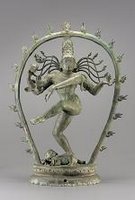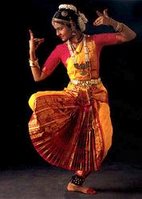 The Indian dance is one of the oldest art that has been through a steady development for nearly two thousand years.
The Indian dance is one of the oldest art that has been through a steady development for nearly two thousand years.From a Hindu point of view, the whole Universe is being brought into existence as the manifestation of the dance of the Supreme Dancer, Nataraja.
In the Hindu scriptures, every god has his or her own style (lasya and tandava respectively represent two aspects of dance) we read about 23 celestial beings called Apsaras (female spirit of the clouds and waters) who dance to please the gods and express the supreme truths in the magic of movement.
The Indian classical dance has its origin in the temples, especially in the South and Eastern India, where it was used to illustrate the Hindu mythology and to be part of a sacred rituals. This art was performed in the temples by the Devadasis, ladies who dedicated themselves to God and His different aspects through the elaborate language of mime and gestures. With the passage of time, this form of art was used both as a means to worship God and a way to express one's emotion or state of mind.
 This form of art is based on the NatyaShastra which is the most ancient and the most elaborate scripture describing every element and aspect of this sacred art-worship.written by Sage Bharata. The supreme manifestation of the Indian dance is Lord Shiva, also referred as Lord Nataraja.
This form of art is based on the NatyaShastra which is the most ancient and the most elaborate scripture describing every element and aspect of this sacred art-worship.written by Sage Bharata. The supreme manifestation of the Indian dance is Lord Shiva, also referred as Lord Nataraja.The temple dance gradually evolved into what is known today as the South Indian Classical dances that still preserves many ritualistic elements of Hinduism. Some of the Classical Indian dancers are believed to be incarnations of apsaras.
South Indian Classical dances that still preserves many ritualistic elements of Hinduism. Some of the Classical Indian dancers are believed to be incarnations of apsaras.
All dance forms follow the same gestures or hasta mudras for each of these rasas. The major schools of classical dances in India are Kathak, Manipuri, Odissi, Bharatha Natyam, Kuchipudi, Kathakali and Mohiniattam, apart from the Folk and Tribal dances.
Sources: http://www.geocities.com/Tokyo/Shrine/4287/dances.htm and
Wikipédia articles : worship dance and sacred dance

Aucun commentaire:
Enregistrer un commentaire